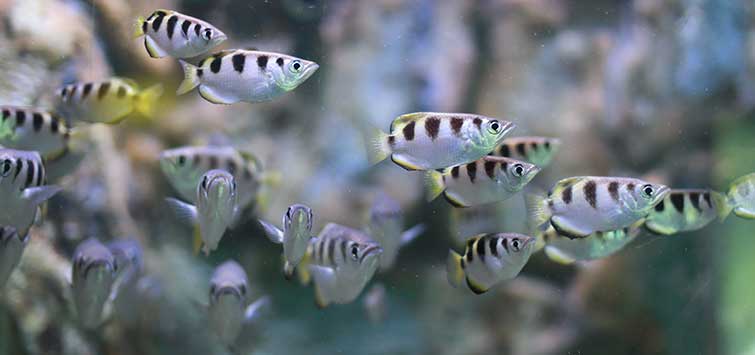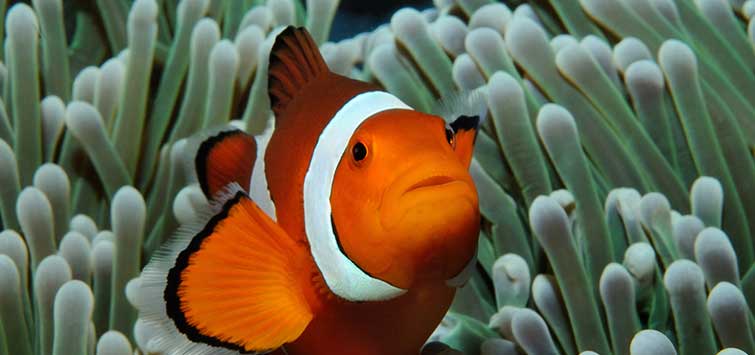The Status of Fish in the Philippines: A Hobbyist's Perspective
Author: David Gamble
In his travels to the Philippines, a long-time aquarium hobbyist visits local fish farms and pet shops to learn something about the current status of fish in the country.
A Little Background
On a recent trip to the Philippines, I was able to see many interesting sights. By paying visits to some of the country’s pet shops and fish farms, I was able to see how the fish and other wildlife were being treated, as well as what, if anything, was being done to help with the conservation of species.
To give some background, the Philippines is a country a little northeast of Malaysia and South of China. There are five main islands and over 7000 smaller ones. The population of more than 91 million live mainly on the five larger islands, the biggest being Luzon, where the capital of Manila is located. Manila itself has a population of about 10 million people. Tagalog is the local language on the island of Luzon. There are eight principal languages and many dialects, but the official language is Filipino. English is widely spoken in the cities, but not so much in the rural areas. The Philippines is actually the third largest English speaking country in the world.
Taxi!
My base was in Makati, which is one of about 10 separate cities of the Manila metropolitan area. Makati is what is known as the business center of Manila and is certainly cleaner and tidier than the others, with many large buildings and an incredible skyline. Getting around Manila is problematic due to excessive traffic. Navigating rush hour traffic is a rather frightening experience, and driving is best left to the local people who are used to the dangerous conditions.
Taxis are readily available and are not expensive. A common mode of transport is the jeepney, which resembles a cross between a jeep and a small, single-decker bus. Some of these jeepneys are very colorfully decorated, with the route displayed on the vehicle’s side. You enter from the rear, and payment is usually passed along fellow passengers to the driver. Mopeds with sidecars are also widely used, as are tricycles, but I would be extremely concerned about having my legs sticking out the side of these, only inches away from rushing traffic.
Living Conditions
As someone who is interested in environmental issues, I was keen to observe as much as I could see of the native environment. Sometimes what I saw gave me grave concerns for future safe-living conditions for both wildlife and people. The cities are generally fine in normally built-up areas, but many large areas of slums adjoin parts of the cities. These slum areas are like small towns but have no sewage systems and seldom have more than a “borrowed” hosepipe for running water. As a result it is easy to see the stains of the waste runoff from open untreated sewage running down walls and into streams and rivers.
It is encouraging to note that the Philippine government has lately attempted to clean up a lot of these areas and has built a considerable amount of affordable housing for these people. Surprisingly, many simply sold these houses and moved back into the slums, which is a way of life to many. I was surprised to see that several of the people living in these slums had jeepneys, or mopeds and tricycles, parked nearby; many did have real jobs but preferred to live the way they did. The people wandering around these areas were well dressed and tidy, but the living conditions looked appalling.
The Fishes of Lake Taal
One of the first places I was keen on seeing was the Taal volcano and Taal Lake (formerly Lake Bombon) in Batangas. This is in a district called Calabarzon. It is in the Batangas province and is 1½ hours away from Makati. I had heard that this large lake was home to four endemic freshwater fish. This included two gobies and Sardinella tawilis. This fish is one of the most economically important fish in the Philippines and is known locally as “tawilis” (local sardine). It is the only known fish of this family known to inhabit fresh water; indeed this lake is 10 km (6 miles) from the sea. The tawilis grows to a maximum size of 15 cm (6 inches) and is an important food fish. I usually saw these being offered for sale at around 10 cm (4 inches) TL.
The four endemic fish species that call Taal Lake home are now endangered. In 1984 the harvest of tawilis was 29,000 tons, but by 1995 it was only 60 tons. Overfishing is the main cause of the dwindling numbers of all these fish species, but also of concern are plans to use the lake water for irrigation and domestic water supplies. Of interest to aquarists are two common ornamental fish, the archerfish Toxotes jaculatrix and the scat Scatophagus argus. The scat is fished as an important food fish. Surprisingly the lake water did not taste at all salty as I suspected it might, as the scat is known to like brackish water.
Picnic Grove
My first view of this magnificent lake was from Picnic Grove, a very nice park set up by the government for public use. Although high above the lake, it gave a superb panoramic view of the lake and its large volcanic island, with its rather imposing crater. This volcano is still active and is constantly monitored for activity.
Fish Farms Galore
As I walked to the lower end of this park I was shocked at the sight before my eyes. A few miles away, but highly visible, were large areas of tilapia fish farms. There were many fish farms, all side-by-side, known as co-operatives. They have been there for over 20 years and may have something to do with the declining numbers of tawilis.
A half-hour drive took me down to a nice large fishing village on the shores of the lake and to the tilapia fish farms. It was difficult to get to the actual shore of the lake due to the houses that had been built on every space along the lake edge. It seemed like every house owner had a fish farm on the lake. These magnificent structures were floating ponds and walkways usually with equipment sheds on each. Some even had garden areas and trees—all floating. There were literally hundreds of these individual farms.
Oreochromis niloticus
The fish they all held were Oreochromis niloticus, the Nile tilapia. These were being grown for food purposes. They were not being bred here; they were bought from other fish farms as fry and only grown in this location.
The thought was that since Lake Taal was such a large body of water, conditions in the water were unlikely to be affected by heavy feeding of these tilapia. They were all held in large nets of varying thickness, depending on the size of the fish held. Since they are mouthbrooders, the theory was that if any bred, egg retrieval would be impossible and they would be lost through the nets. Although the possible size of a full grown adult is much greater, I usually saw these fish being packaged for sale at about 20 to 25 cm (8 to 10 inches).
Escapees
My greatest concern for the endemic lake fish are the quite-probable escapees, which would likely out-compete the native fish (as tilapia have done in many parts of the world). These tilapia were not only being grown for the Philippine market, but also as a major food export to many countries including China and the United States.
Visiting the Aquarium Shops
I had read a little about Cartimer Street in Pasay City, another location within Metro Manila. This was fascinating, as the area concerned had rows of aquarium shops. Also in the same location there were other pet shops selling every exotic pet you could think of (and many more). As is the usual, there were many flower shops and plant stalls. The were more than 20 shops selling fish, and they had some most unusual species, like crowntail bettas, combtail bettas, and some very sought after fish like Cuban cichlids. There were also several very nice, large arowanas, which are popular all over Asia.
Cleanliness
Of particular note was the cleanliness of some of the shops selling dogs. One shop in particular was spotless, and had cooling fans to give the dogs some comfort. Anyone wishing to handle a dog had to wash his or her hands in alcohol first. These dogs were pedigreed and were for sale at similar prices as Great Britain, where I am from. I saw no evidence of dogs being mistreated; on the contrary, the dogs in these pet shops were treated with more love and care than is normally seen even in my country of animal lovers.
A Long Aquarium Strip
In Paranaque City (another part of Metro Manila), I visited a very large aquarium shop and wholesale business, exporting live fish from all over the world. This shop boasts having the country’s longest aquarium strip. It certainly was the longest I had ever seen, having four columns of tanks for a length of approximately 60 to 70 meters (197 to 230 feet). Besides the normal aquarium fish I expected to see, there were a few more unusual fish here.
Big Fish
The biggest part of this business was its numerous pools and ponds with many large fish like gars, shovelnose cats, arowanas, stingrays, and many others. The koi section was most likely the main business of this company. Large ponds containing some very impressive-looking koi originating from Japan were seen here. Koi being readied for export were housed in separate ponds labeled with instructions for feeding, etc. Of course no food was given to fish for export within two days of transport. My guide, Mr. Samson, who is the assistant manager of this establishment, was keen to show me all I wished to see. A side entrance opened out into a large conference room, which had dozens of tanks with breeding frontosa all around the room.
From a distance I saw some areas where aquarium and pond plants were on sale. I was then shown the marine section. This was very tidy and contained more species of clownfish and damsels than I knew existed. I didn’t see anything notoriously difficult to keep alive in captivity. Also encouraging, I was told that many marine fish were bred locally and not taken from the wild.
Scoping Out a Fish Farm
After a few days doing tourist things I was then taken to visit another fish farm. On the way I passed rice fields and saw many areas where rice was laid out on the road to dry. These patches of rice covered one side of the road for 50 yards (150 feet) or so and were avoided by traffic.
There were many distance signs on the roadsides depicting the “death march” where, in 1942, the Japanese made the Filipino people march for many miles with little food or water; many died along the way. It was sad to learn of the hardships suffered by so many on this journey.
My Investigation
Well into the countryside and along a dirt track, we came to a sign advertising the fish farm that sold sex reversal tilapia. I was keen to find out more. On arrival we were met by the owner, who showed us around. Our first sight was the open office opposite the main house. Some pools with baby tilapia were alongside. Beside these pools and immediately opposite the house was a large collection of trees, many bearing fruit. Fruit trees are a familiar sight in the Philippines, with trees in almost every garden and waste ground.
On exiting the side of the office we were met by a large expanse of football-field-size ponds covering several acres. A small stream flowed down the side of the fish farm, which is where the water supply came from. Just below the farm was a river. There were many ponds, some were divided by netting and most had signposts stating the size or age of the fish they contained. The narrow foot walks between the ponds required careful footing and in several areas only a plank of wood was there to walk on as a bridge. The owner spoke little English but fortunately our charming translator asked our questions.
Breeding
This fish farm was not there to specifically grow the fish for food but it was there to breed and supply fingerlings to other fish farms so they could grow the young to market size. I assumed that it was easier to breed the fish in smaller, more controlled environments and to let the farms on the lakes grow the fish to the right length. This was possible due to the larger volume of water on the lakes, which allowed for heavy feeding of the fish. Tilapia, in any case, are well known for their ability to be resistant to poor water conditions resulting from overcrowding and overfeeding. Unfortunately the other fish in the lakes may not be so resistant and it may only be a matter of time before we lose another endemic fish (meaning one not found anywhere else).
Findings
It became clear that the owner had no proper knowledge of the fish species he had, nor of how it came to be. I asked what species these originated from, but he was only able to state where he got his stock from. He did, however, know they were crossbred.
On further investigation I found out that they were a cross between O. mossambicus and O. niloticus. These hybrids grew quicker and bigger than their original parents and so were of benefit as a food fish. These fish were also treated with hormones when young so only bigger, stronger males would be produced. Again, this is all in the name of commercial activities. These fish were fertile and concern must be had for escapees, which get out regularly in times of floods. I saw many escaped tilapia fry beside the river in the small stream. They were swimming against the current and were all congregated in very small ponds formed by mesh dirt traps.
Encouraging Signs
There were some encouraging signs of conservation efforts taking place. I did see one turtle conservation area where the wild turtles came ashore to lay their eggs. The beach was actually a tourist beach club so the eggs were dug up and placed in protective areas and labeled with the date and the individual who laid them. They were able to do this as the turtles were tagged, and it was always a tourist pleaser to watch these animals come up the beach and lay eggs. Sponsorship was available, as were t-shirts and other tourist goods. However, I was left feeling that these turtles were little more than part of a money-making scheme, and that actual preservation was perhaps not as important as was being portrayed.
All in all, the Filipino people are very nice and polite. At one time, I had five young shop girls searching for a compact disc I was looking for. This is normal, as they are always willing to go out of their way to help. In general they seemed to have little knowledge of the need for conservation efforts, though, which is a pity. Hopefully I will return someday, and I hope to see less obvious pollution in rivers and waterways. The government has an enormous task ahead of them, but they are trying, and many people realize and appreciate this.
See the full article on TFH Digital http://www.tfhdigital.com/tfh/200711/#pg96

.png?h=595&iar=0&w=2781&hash=5FD5E69473BCC22199FBFA2FB71B6033)



